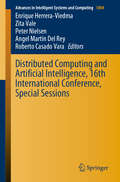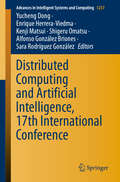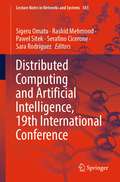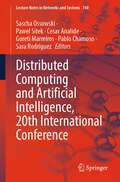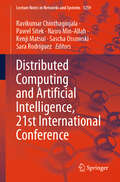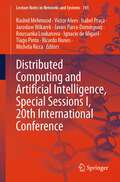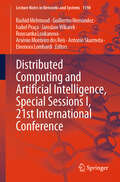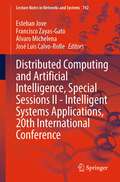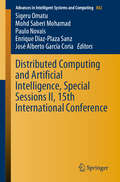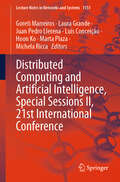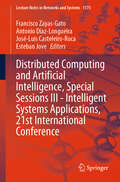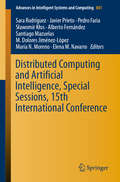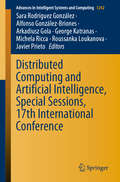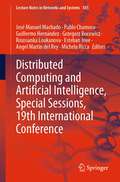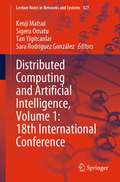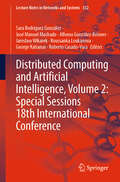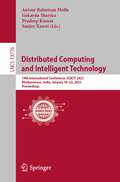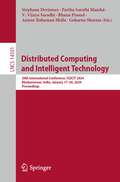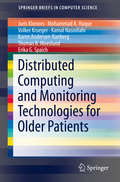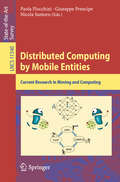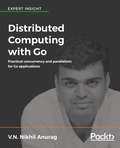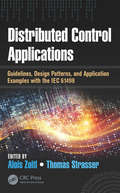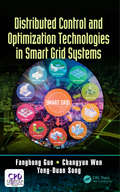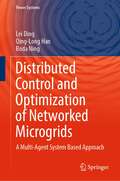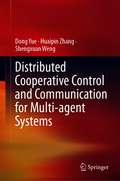- Table View
- List View
Distributed Computing and Artificial Intelligence, 16th International Conference, Special Sessions (Advances in Intelligent Systems and Computing #1004)
by Zita Vale Enrique Herrera-Viedma Peter Nielsen Angel Martin Del Rey Roberto Casado VaraThis book presents the outcomes of the special sessions of the 16th International Conference on Distributed Computing and Artificial Intelligence 2019, a forum that brought together ideas, projects and lessons associated with distributed computing and artificial intelligence, and their applications in various areas. Artificial intelligence is currently transforming our society. Its application in distributed environments, such as the internet, electronic commerce, environmental monitoring, mobile communications, wireless devices, and distributed computing, to name but a few, is continuously increasing, making it an element of high added value and tremendous potential. These technologies are changing constantly as a result of the extensive research and technical efforts being pursued at universities and businesses alike. The exchange of ideas between scientists and technicians from both the academic and industrial sectors is essential to facilitating the development of systems that can meet the ever-growing demands of today’s society. This year’s technical program was characterized by high quality and diversity, with contributions in both well-established and evolving areas of research. More than 120 papers were submitted to the main and special sessions tracks from over 20 different countries (Algeria, Angola, Austria, Brazil, Colombia, France, Germany, India, Italy, Japan, the Netherlands, Oman, Poland, Portugal, South Korea, Spain, Thailand, Tunisia, the United Kingdom and United States), representing a truly “wide area network” of research activity. The symposium was jointly organized by the Osaka Institute of Technology and the University of Salamanca. This year’s event was held in Avila, Spain, from 26th to 28th June, 2019. The authors wish to thank the sponsors: the IEEE Systems Man and Cybernetics Society, Spain Section Chapter and the IEEE Spain Section (Technical Co-Sponsor), IBM, Indra, Viewnext, Global Exchange, AEPIA, APPIA and AIR institute.
Distributed Computing and Artificial Intelligence, 17th International Conference (Advances in Intelligent Systems and Computing #1237)
by Yucheng Dong Kenji Matsui Enrique Herrera-Viedma Sara Rodríguez González Shigeru Omatsu Alfonso González BrionesThis book brings together past experience, current work and promising future trends associated with distributed computing, artificial intelligence and their application in order to provide efficient solutions to real problems. DCAI 2020 is a forum to present applications of innovative techniques for studying and solving complex problems in artificial intelligence and computing areas. This year’s technical program will present both high quality and diversity, with contributions in well-established and evolving areas of research. Specifically, 83 papers were submitted to main track and special sessions, by authors from 26 different countries representing a truly “wide area network” of research activity. The DCAI’20 technical program has selected 35 papers and, as in past editions, it will be special issues in ranked journals. This symposium is organized by the University of L'Aquila (Italy). We would like to thank all the contributing authors, the members of the Program Committee and the sponsors (IBM, Armundia Group, EurAI, AEPIA, APPIA, CINI, OIT, UGR, HU, SCU, USAL, AIR Institute and UNIVAQ).
Distributed Computing and Artificial Intelligence, 19th International Conference (Lecture Notes in Networks and Systems #583)
by Sara Rodríguez Rashid Mehmood Sigeru Omatu Pawel Sitek Serafino CiceroneDCAI 2022 is a forum to present applications of innovative techniques for studying and solving complex problems in artificial intelligence and computing areas. The present edition brings together past experience, current work and promising future trends associated with distributed computing, artificial intelligence and their application in order to provide efficient solutions to real problems. This year’s technical program will present both high quality and diversity, with contributions in well-established and evolving areas of research. Specifically, 61 papers were submitted, by authors from 28 different countries representing a truly “wide area network” of research activity. The DCAI’22 technical program has selected 32 full papers and, as in past editions, it will be special issues in ranked journals. This symposium is organized by the University of L'Aquila (Italy). We would like to thank all the contributing authors, the members of the Program Committee and the sponsors (IBM, Indra, Dipartimento di Ingegneria e Scienze dell'Informazione e Matematica dell'Università degli Studi dell'Aquila, Armundia Group, Whitehall Reply, T.C. Technologies And Comunication S.R.L., LCL Industria Grafica, AIR Institute, AEPIA, APPIA).
Distributed Computing and Artificial Intelligence, 20th International Conference (Lecture Notes in Networks and Systems #740)
by Sascha Ossowski Cesar Analide Sara Rodríguez Goreti Marreiros Pablo Chamoso Pawel SitekThe present book brings together experience, current work, and promising future trends associated with distributed computing, artificial intelligence, and their application in order to provide efficient solutions to real problems. DCAI 2023 is a forum to present applications of innovative techniques for studying and solving complex problems in artificial intelligence and computing areas. This year’s technical program presents both high quality and diversity, with contributions in well-established and evolving areas of research. Specifically, 108 papers were submitted, by authors from 31 different countries representing a truly “wide area network” of research activity. The DCAI 23 technical program has selected 36 full papers in the main track and, as in past editions, there will be special issues in ranked journals. This symposium is organized by the LASI and Centro Algoritmi of the University of Minho (Portugal). The authors like to thank all the contributing authors, the members of the Program Committee, National Associations (AEPIA, APPIA), and the sponsors (AIR Institute).
Distributed Computing and Artificial Intelligence, 21st International Conference (Lecture Notes in Networks and Systems #1259)
by Sascha Ossowski Sara Rodríguez Kenji Matsui Pawel Sitek Ravikumar Chinthaginjala Nasro Min-AllahThis book serves as a forum to present applications of innovative techniques for studying and solving complex problems in artificial intelligence and computing. This edition brings together experience, current work, and promising future trends related to distributed computing, artificial intelligence, and their applications to provide efficient solutions to real-world problems. The technical program this year is both high in quality and diverse, featuring contributions from well-established and evolving research areas. Specifically, 138 papers were submitted by authors from 43 different countries, representing a truly global network of research activity. The DCAI’24 technical program has selected 36 full papers for the main track, and as in previous editions, there will be special issues in ranked journals. This symposium is organized by the University of Salamanca (Spain). The authors would like to thank all the contributing authors, the program committee members, National Associations (AEPIA, APPIA, LASI), and the sponsors (AIR Institute).
Distributed Computing and Artificial Intelligence, Special Sessions I, 20th International Conference (Lecture Notes in Networks and Systems #741)
by Ricardo Nunes Tiago Pinto Rashid Mehmood Roussanka Loukanova Michela Ricca Isabel Praça Victor Alves Jarosław Wikarek Javier Parra-Domínguez Ignacio De MiguelThe present book brings together experience, current work, and promising future trends associated with distributed computing, artificial intelligence, and their application in order to provide efficient solutions to real problems. DCAI 2023 is a forum to present applications of innovative techniques for studying and solving complex problems in artificial intelligence and computing areas. This year’s technical program presents both high quality and diversity, with contributions in well-established and evolving areas of research. Specifically, 108 papers were submitted, by authors from 31 different countries representing a truly “wide area network” of research activity. The DCAI’23 technical program has selected 50 full papers in the Special Sessions (ASET, AIMPM, AI4CS, CLIRAI, TECTONIC, PSO-ML, SmartFoF, IoTalentum) and, as in past editions, it will be special issues in ranked journals. This symposium is organized by the LASI and Centro Algoritmi of the University of Minho (Portugal). The authors like to thank all the contributing authors, the members of the Program Committee, National Associations (AEPIA, APPIA), and the sponsors (AIR Institute).
Distributed Computing and Artificial Intelligence, Special Sessions I, 21st International Conference (Lecture Notes in Networks and Systems #1198)
by Antonio Skarmeta Rashid Mehmood Roussanka Loukanova Isabel Praça Jaroslaw Wikarek Guillermo Hernández Arsénio Monteiro dos Reis Eleonora LombardiThis book presents applications of innovative techniques for studying and solving complex problems in artificial intelligence and computing. This edition brings together experience, current work, and promising future trends related to distributed computing, artificial intelligence, and their applications to provide efficient solutions to real-world problems. Given the conference's success, this edition features twelve special sessions covering a wide range of topics related to AI and other areas of interest. These sessions were carefully curated to address the latest advancements and challenges in fields such as machine learning, neural networks, IoT, big data, and blockchain, among others. The accepted papers from these sessions are presented in two volumes, showcasing the diverse and innovative research being conducted in these domains. This is the first volume, which includes the sessions: Artificial intelligence for enhanced cyber security (AI4CS), AI-driven methods for multimodal networks and processes modeling (AIMPM), computational linguistics, information, reasoning, and AI (CLIRAI), novel technologies for smart industry and mobility (SmartMob), intelligent Internet of things security and privacy (WISP) and revolutionizing carbon farming by nature-based business models and emerging innovations in the field of artificial intelligence, satellite and green technologies (INNO4CFIS), each focusing on specific themes within the broader scope of AI and its applications. The DCAI’24 technical program has selected 74 papers in special sessions and, as in past editions, it will be special issues in ranked journals. This symposium is organized by the University of Salamanca (Spain). The authors would like to thank all the contributing authors, the program committee members, national associations (AEPIA, APPIA, LASI), and the sponsors (AIR Institute).
Distributed Computing and Artificial Intelligence, Special Sessions II - Intelligent Systems Applications, 20th International Conference (Lecture Notes in Networks and Systems #742)
by Esteban Jove Francisco Zayas-Gato Álvaro Michelena José Luis Calvo-RolleThis book of LNNS contains accepted papers presented at DCAI conference in the Special Session on Intelligent Systems Applications (ISA), Guimarães (Portugal), July 2023. ISA is a major forum for presentation of development and applications of innovative techniques in the fields of building management, assistive technologies, the applied engineering, and industry. The scientific committee of the ISA has selected 8 full papers for its publication. This year ISA Special Session has teamed up with “Logic Journal of the IGPL” (Oxford University Press) for one special issue including selected papers from ISA Special Session 2023. We would like to thank all the contributing authors, the members of the Program Committee, the Organizing Committee of the Universities of Minho, and Salamanca for their hard and highly valuable work, which has been essential for the success of ISA 2023.
Distributed Computing and Artificial Intelligence, Special Sessions II, 15th International Conference (Advances in Intelligent Systems and Computing #802)
by Paulo Novais Mohd Saberi Mohamad Sigeru Omatu Enrique Díaz-Plaza Sanz José Alberto García CoriaThis book addresses a broad range of topics, from newly proposed techniques in Artificial Intelligence (AI) and Machine Learning to various applications such as decision-making, pattern classification for data, image and signals, robotics, and control systems. Big data applications are discussed, while improved methods and wholly new methods for using deep learning technologies are also presented. The topics covered are comprehensive and reflect a wide range of technologies in the area. In particular, the latest methods in deep learning approaches and applications are discussed in many parts of the book, providing a better understanding of these new technologies. The book’s general scope includes the latest methods in the areas of Artificial Intelligence and Machine Learning for use in distributed computing as well as decision support systems. As the book covers a rather wide area, its intended readership ranges from those working in AI and machine learning technologies to those working on applications utilizing these technologies, researchers new to these areas who need background information on the technologies and applications, and more experienced researchers looking for new methods and applications.
Distributed Computing and Artificial Intelligence, Special Sessions II, 21st International Conference (Lecture Notes in Networks and Systems #1151)
by Goreti Marreiros Michela Ricca Laura Grande Juan Pedro Llerena Luís Conceição Hoon Ko Marta PlazaDCAI 2024 serves as a forum to present applications of innovative techniques for studying and solving complex problems in artificial intelligence and computing. This edition brings together experience, current work, and promising future trends related to distributed computing, artificial intelligence, and their applications to provide efficient solutions to real-world problems. Given the conference's success, this edition features twelve special sessions covering a wide range of topics related to AI and other areas of interest. These sessions were carefully curated to address the latest advancements and challenges in fields such as machine learning, neural networks, IoT, big data, and blockchain, among others. The accepted papers from these sessions are presented in two volumes, showcasing the diverse and innovative research being conducted in these domains. This is the first volume, which includes the sessions: Advanced AI-based Data Annotation Tools (AI-DAT), Digital Heritage Contents (DHC), female technopreneurs and early career researchers in distributed computing and AI organised by the Gendered Innovation Living Labs (GILL), New perspectives and solutions in Cultural Heritage (TECTONIC), Artificial Intelligence trends in Health & Care (AItHeC) & Doctoral Consortiums), each focusing on specific themes within the broader scope of AI and its applications. The DCAI’24 technical program has selected 74 papers in special sessions and, as in past editions, it will be special issues in ranked journals. This symposium is organized by the University of Salamanca (Spain). We would like to thank all the contributing authors, the Program Committee members, National Associations (AEPIA, APPIA, LASI), and the sponsors (AIR Institute).
Distributed Computing and Artificial Intelligence, Special Sessions III - Intelligent Systems Applications, 21st International Conference (Lecture Notes in Networks and Systems #1173)
by Esteban Jove Francisco Zayas-Gato Antonio Díaz-Longueira José-Luis Casteleiro-RocaThis volume of LNNS contains accepted papers presented at DCAI conference in the Special Session on Intelligent Systems Applications (ISA), Salamanca (Spain), June 2024. ISA is a major forum for presentation of development and applications of innovative techniques in the fields of building management, assistive technologies, the applied engineering, and industry. The scientific committee of the ISA has selected 9 full papers for its publication. This year ISA Special Session has teamed up with “Logic Journal of the IGPL” (Oxford University Press) for one special issue including selected papers from ISA Special Session 2024. We would like to thank all the contributing authors, National Associations (AEPIA, APPIA), and sponsors (AIR Institute). Finally, we are grateful and value the hard work of the Program Committee members and the Organizing Committee of the University of Salamanca which has been essential for the success of the ISA Special Session 2024.
Distributed Computing and Artificial Intelligence, Special Sessions, 15th International Conference (Advances in Intelligent Systems and Computing #801)
by Sara Rodríguez María N. Moreno Alberto Fernández Pedro Faria Javier Prieto Sławomir Kłos Santiago Mazuelas M. Dolores Jiménez-López Elena M. NavarroThis book presents the outcomes of the 15th International Conference on Distributed Computing and Artificial Intelligence, held in Toledo (Spain) from 20th to 22nd June 2018 and hosted by the UCLM, and which brought together researchers and developers from industry, education and the academic world to report on the latest scientific research, technical advances and methodologies. Highlighting multi-disciplinary and transversal aspects, the book focuses on the conferences Special Sessions, including Advances in Demand Response and Renewable Energy Sources in Smart Grids (ADRESS); AI- Driven Methods for Multimodal Networks and Processes Modeling (AIMPM); Social Modelling of Ambient Intelligence in Large Facilities (SMAILF); Communications, Electronics and Signal Processing (CESP); Complexity in Natural and Formal Languages (CNFL); and Web and Social Media Mining (WASMM).
Distributed Computing and Artificial Intelligence, Special Sessions, 17th International Conference (Advances in Intelligent Systems and Computing #1242)
by Javier Prieto Alfonso González-Briones Roussanka Loukanova Sara Rodríguez González Arkadiusz Gola George Katranas Michela RiccaThis book brings together past insights, current research and promising future trends associated with distributed computing, artificial intelligence and their application in order to provide efficient solutions to real-world problems. The book is based on the International Conference on Distributed Computing and Artificial Intelligence 2020 (DCAI 2020), which provided a forum to present applications of innovative techniques for studying and solving complex problems in artificial intelligence and computing areas. It includes contributions on well-established and evolving areas of research, by authors from 26 countries, representing a truly “wide area network” of research activity
Distributed Computing and Artificial Intelligence, Special Sessions, 19th International Conference (Lecture Notes in Networks and Systems #585)
by Pablo Chamoso Grzegorz Bocewicz Roussanka Loukanova Michela Ricca José Manuel Machado Guillermo Hernández Esteban Jove Angel Martin del ReyDCAI 2022 is a forum to present applications of innovative techniques for studying and solving complex problems in artificial intelligence and computing areas. The present edition brings together past experience, current work and promising future trends associated with distributed computing, artificial intelligence and their application in order to provide efficient solutions to real problems. This year’s technical program will present both high quality and diversity, with contributions in well-established and evolving areas of research. Specifically, 46 papers were submitted, by authors from 28 different countries representing a truly “wide area network” of research activity. The DCAI’22 Special Sessions technical program has selected 22 papers (12 full papers) and, as in past editions, it will be special issues in ranked journals. This symposium is organized by the University of L'Aquila (Italy). We would like to thank all the contributing authors, the members of the Program Committee and the sponsors (IBM, Indra, Dipartimento di Ingegneria e Scienze dell'Informazione e Matematica dell'Università degli Studi dell'Aquila, Armundia Group, Whitehall Reply, T.C. Technologies And Comunication S.R.L., LCL Industria Grafica, AIR Institute, AEPIA, APPIA).
Distributed Computing and Artificial Intelligence, Volume 1: 18th International Conference (Lecture Notes in Networks and Systems #327)
by Sigeru Omatu Tan Yigitcanlar Kenji Matsui Sara Rodríguez GonzálezThis book offers the exchange of ideas between scientists and technicians from both the academic and industrial sector which is essential to facilitate the development of systems that can meet the ever-increasing demands of today’s society. The 18th International Symposium on Distributed Computing and Artificial Intelligence 2021 (DCAI 2021) is a forum to present the applications of innovative techniques for studying and solving complex problems in artificial intelligence and computing areas. The present edition brings together past experience, current work, and promising future trends associated with distributed computing, artificial intelligence, and their application in order to provide efficient solutions to real problems. This year’s technical program presents both high quality and diversity, with contributions in well-established and evolving areas of research. Specifically, 55 papers were submitted to main track and special sessions, by authors from 24 different countries, representing a truly “wide area network” of research activity. The DCAI’21 technical program has selected 21 papers, and, as in past editions, it will be special issues in ranked journals such as Electronics, Sensors, Systems, Robotics, Mathematical Biosciences and ADCAIJ. These special issues cover extended versions of the most highly regarded works. Moreover, DCAI'21 special sessions have been a very useful tool to complement the regular program with new or emerging topics of particular interest to the participating community.
Distributed Computing and Artificial Intelligence, Volume 2: Special Sessions 18th International Conference (Lecture Notes in Networks and Systems #332)
by Alfonso González-Briones Roussanka Loukanova Roberto Casado-Vara Sara Rodríguez González George Katranas José Manuel Machado Jaroslaw WikarekThis book highlights the latest research on distributed computing and artificial intelligence. DCAI 2021 is a forum to present applications of innovative techniques for studying and solving complex problems in artificial intelligence and computing areas. The present edition brings together past experience, current work and promising future trends associated with distributed computing, artificial intelligence and their application in order to provide efficient solutions to real problems. This year’s technical program will present both high quality and diversity, with contributions in well-established and evolving areas of research. Specifically, 55 papers were submitted to main track and special sessions, by authors from 24 different countries representing a truly “wide area network” of research activity. Moreover, DCAI 2021 Special Sessions have been a very useful tool in order to complement the regular program with new or emerging topics of particular interest to the participating community. The technical program of the Special Sessions of DCAI 2021 has selected 23 papers. We would like to thank all the contributing authors, the members of the Program Committees, the sponsors (IBM, Armundia Group, EurAI, AEPIA, APPIA, CINI, OIT, UGR, HU, SCU, USAL, AIR Institute and UNIVAQ) and the Organizing Committee of the University of Salamanca for their hard and highly valuable work.
Distributed Computing and Intelligent Technology: 19th International Conference, ICDCIT 2023, Bhubaneswar, India, January 18–22, 2023, Proceedings (Lecture Notes in Computer Science #13776)
by Pradeep Kumar Anisur Rahaman Molla Gokarna Sharma Sanjay RawatThis book constitutes the proceedings of the 19th International Conference on Distributed Computing and Intelligent Technology, ICDCIT 2023, which was held in Bhubaneswar, India, in January 2023.The 20 full papers and 9 short papers presented in this volume were carefully reviewed and selected from 55 submissions. The papers are organized in the following topical sections: Invited Talks; Distributed Computing; Intelligent Technology.
Distributed Computing and Intelligent Technology: 20th International Conference, ICDCIT 2024, Bhubaneswar, India, January 17–20, 2024, Proceedings (Lecture Notes in Computer Science #14501)
by Bhanu Prasad Stéphane Devismes Anisur Rahaman Molla Gokarna Sharma Partha Sarathi Mandal V. Vijaya SaradhiThis book constitutes the refereed proceedings of the 20th International Conference on Distributed Computing and Intelligent Technology, ICDCIT 2024, which was held in Bhubaneswar, India, during January 17–20, 2024. The 24 full papers presented in this volume were carefully reviewed and selected from 116 submissions. The papers are organized in the following topical sections: Distributed Computing (DC) and Intelligent Technology (IT). The DC track solicits original research papers contributing to the foundations and applications of distributed computing, whereas the IT track solicits original research papers contributing to the foundations and applications of Intelligent Technology.
Distributed Computing and Monitoring Technologies for Older Patients
by Thomas B. Moeslund Juris Klonovs Mohammad A. Haque Volker Krueger Kamal Nasrollahi Karen Andersen-Ranberg Erika G. SpaichThis book summarizes various approaches for theautomatic detection of health threats to older patients at home living alone. Thetext begins by briefly describing those who would most benefit from healthcaresupervision. The book then summarizes possible scenarios for monitoring anolder patient at home, deriving the common functional requirements formonitoring technology. Next, the work identifies the state of the art oftechnological monitoring approaches that are practically applicable to geriatricpatients. A survey is presented on a range of such interdisciplinary fields assmart homes, telemonitoring, ambient intelligence, ambient assisted living,gerontechnology, and aging-in-place technology. The book discusses relevantexperimental studies, highlighting the application of sensor fusion, signalprocessing and machine learning techniques. Finally, the text discusses futurechallenges, offering a number of suggestions for further research directions.
Distributed Computing by Mobile Entities: Current Research in Moving and Computing (Lecture Notes in Computer Science #11340)
by Paola Flocchini Giuseppe Prencipe Nicola SantoroDistributed Computing by Mobile Entities is concerned with the study of the computational and complexity issues arising in systems of decentralized computational entities operating in a spatial universe Encompassing and modeling a large variety of application environments and systems, from robotic swarms to networks of mobile sensors, from software mobile agents in communication networks to crawlers and viruses on the web, the theoretical research in this area intersects distributed computing with the fields of computational geometry (especially for continuous spaces), control theory, graph theory and combinatorics (especially for discrete spaces). The research focus is on determining what tasks can be performed by the entities, under what conditions, and at what cost. In particular, the central question is to determine what minimal hypotheses allow a given problem to be solved. This book is based on the lectures and tutorial presented at the research meeting on “Moving and Computing" (mac) held at La Maddalena Island in June 2017. Greatly expanded, revised and updated, each of the lectures forms an individual Chapter. Together, they provide a map of the current knowledge about the boundaries of distributed computing by mobile entities.
Distributed Computing with Go: Practical concurrency and parallelism for Go applications
by V.N. Nikhil AnuragA tutorial leading the aspiring Go developer to full mastery of Golang's distributed features. Key Features This book provides enough concurrency theory to give you a contextual understanding of Go concurrency It gives weight to synchronous and asynchronous data streams in Golang web applications It makes Goroutines and Channels completely familiar and natural to Go developers Book Description Distributed Computing with Go gives developers with a good idea how basic Go development works the tools to fulfill the true potential of Golang development in a world of concurrent web and cloud applications. Nikhil starts out by setting up a professional Go development environment. Then you’ll learn the basic concepts and practices of Golang concurrent and parallel development. You’ll find out in the new few chapters how to balance resources and data with REST and standard web approaches while keeping concurrency in mind. Most Go applications these days will run in a data center or on the cloud, which is a condition upon which the next chapter depends. There, you’ll expand your skills considerably by writing a distributed document indexing system during the next two chapters. This system has to balance a large corpus of documents with considerable analytical demands. Another use case is the way in which a web application written in Go can be consciously redesigned to take distributed features into account. The chapter is rather interesting for Go developers who have to migrate existing Go applications to computationally and memory-intensive environments. The final chapter relates to the rather onerous task of testing parallel and distributed applications, something that is not usually taught in standard computer science curricula. What you will learn Gain proficiency with concurrency and parallelism in Go Learn how to test your application using Go's standard library Learn industry best practices with technologies such as REST, OpenAPI, Docker, and so on Design and build a distributed search engine Learn strategies on how to design a system for web scale Who this book is for This book is for developers who are familiar with the Golang syntax and have a good idea of how basic Go development works. It would be advantageous if you have been through a web application product cycle, although it’s not necessary.
Distributed Control Applications: Guidelines, Design Patterns, and Application Examples with the IEC 61499 (Industrial Information Technology #9)
by Thomas Strasser Alois ZoitlDistributed Control Applications: Guidelines, Design Patterns, and Application Examples with the IEC 61499 discusses the IEC 61499 reference architecture for distributed and reconfigurable control and its adoption by industry. The book provides design patterns, application guidelines, and rules for designing distributed control applications based on the IEC 61499 reference model. Moreover, examples from various industrial domains and laboratory environments are introduced and explored.
Distributed Control and Optimization Technologies in Smart Grid Systems (Microgrids and Active Power Distribution Networks)
by Yong-Duan Song Fanghong Guo Changyun WenThe book aims to equalize the theoretical involvement with industrial practicality and build a bridge between academia and industry by reducing the mathematical difficulties. It provides an overview of distributed control and distributed optimization theory, followed by specific details on industrial applications to smart grid systems, with a special focus on micro grid systems. Each of the chapters is written and organized with an introductory section tailored to provide the essential background of the theories required. The text includes industrial applications to realistic renewable energy systems problems and illustrates the application of proposed toolsets to control and optimization of smart grid systems.
Distributed Control and Optimization of Networked Microgrids: A Multi-Agent System Based Approach (Power Systems)
by Qing-Long Han Boda Ning Lei DingThis book presents new techniques and methods for distributed control and optimization of networked microgrids. Distributed consensus issues under network-based and event-triggered mechanisms are first addressed in a multi-agent system framework, which can explicitly characterize the relationship between communication resources and the control performance. Then, considering the effects of network uncertainties, multi-agent system-based distributed schemes are tailored to solve the fundamental issues of networked microgrids such as distributed frequency regulation, voltage regulation, active power sharing/load sharing, and energy management. The monograph will contribute to stimulating extensive interest of researchers in electrical and control fields.
Distributed Cooperative Control and Communication for Multi-agent Systems
by Dong Yue Huaipin Zhang Shengxuan WengThis book investigates distributed cooperative control and communication of MASs including linear systems, nonlinear systems and multiple rigid body systems. The model-based and data-driven control method are employed to design the (optimal) cooperative control protocol.The approaches of this book consist of model-based and data-driven control such as predictive control, event-triggered control, optimal control, adaptive dynamic programming, etc.From this book, readers can learn about distributed cooperative control methods, data-driven control, finite-time stability analysis, cooperative attitude control of multiple rigid bodies. Some fundamental knowledge prepared to read this book is finite-time stability theory, event-triggered sampling mechanism, adaptive dynamic programming and optimal control.
